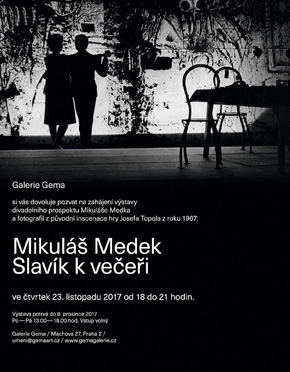
Mikuláš Medek: Theater prospect for J. Topol's play "Nightingale for Dinner", 2017
| Curator: | Linda K. Sedláková |
|---|---|
| Venue: | Galerie Gema, Máchova 27, Praha |
| Dates: | 23. 11. - 15. 12. 2017 |
| Contact: | www.gemagalerie.cz |
| Opening hours: | Mon - Fri 13:00 - 18:00 |

| Curator: | Linda K. Sedláková |
|---|---|
| Venue: | Galerie Gema, Máchova 27, Praha |
| Dates: | 23. 11. - 15. 12. 2017 |
| Contact: | www.gemagalerie.cz |
| Opening hours: | Mon - Fri 13:00 - 18:00 |
The one-act play, which Václav Havel preferred among other friend's works, is characteristically attributed to the works of Czech absurd theater. The family dinner, to which Mr. Nightingale was invited, has the same tragic ending for the guest as the life of every human being: only the prospect of death adds value to life ... or vice versa ...
Each replica of Topol's black comedy takes on existential dimensions, a method reminiscent of Kafka, Pinter, and Beckett.
Playwright: Josef Topol
Stage directors: Director: Josef Topol
Stage designer: Mikuláš Medek
Costume designer: Ivo Fiala
Assistant Director: Helena Glancová
Cast
Father: František Řehák
Mother: Jarmila Derková
Son: Jiří Klem
Daughter: Hana Pastejříková
Slavík: Miroslav Masopust
Mikuláš Medek
The Czech painter Mikuláš Medek was born on November 3, 1926 in Prague. He was the grandson of the Czech impressionist painter Antonín Slavíček, his father was the writer and legionary general Rudolf Medek, his brother was the publicist, journalist and former head of the Václav Havel presidency, Ivan Medek.
From 1942 to 1944, Medek studied at the State School of Graphic Arts in Prague, then briefly studied at the Academy of Fine Arts and the Academy of Arts, Architecture and Design under František Muzika and František Tichý. He did not complete his studies, as he was expelled from all schools as a son of a legionnaire and a First Republic general after the communist coup in 1949. Subsequently, he worked as an auxiliary worker at the Škoda company in Smíchov, Prague, painting only privately. At the time of censorship, he earned extra money by selling his small graphics and restoration work. He also collaborated with Karel Teig, whom he helped publish art collections.
In 1951, Medek married art photographer Emila Tláskalová.
During the period of political liberalization in the 1960s, Medek was accepted into the Union of Fine Artists, in 1963 his first major solo exhibition could take place, and Medek also received his first foreign exhibition. He could also work on public contracts, such as the altarpiece of the church in Jedovnice (1963) and compositions for the interiors of Czechoslovak Airlines offices in Damascus, Košice (both 1963), Paris (1964), Prague Ruzyně (1969) and New York (1970). ).
Medek was one of the most important representatives of Czech modern art. His work was based on the principles of spiritual surrealism, from which he later slowly turned to non-figurative painting. In 1952 he went through the influence of existentialism and his main theme was the human figure. Despite these existential painting compositions, he proceeded to the so-called prepared paintings, based on rationally distributed color formations. After 1964, he returned to figurative and imaginative painting. Medek also devoted himself to book illustration. With his work,
Medek influenced the rising generation of Czech artists, who later found use in informel. These artists and a narrow audience had the opportunity to get acquainted with his works at non-public private exhibitions, so-called Confrontations.
In 1962, Medek was diagnosed with severe diabetes, which was the cause of his subsequent osteoporosis and general weakness. After the fall, his leg became ill and limped, he also suffered from persistent spine pain.
Medek died at the age of 47 on August 23, 1974 in Prague from complications associated with diabetes.